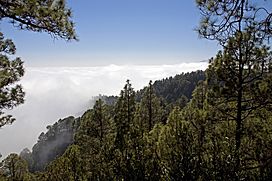Canary Islands dry woodlands and forests facts for kids
Quick facts for kids Canary Islands dry woodlands and forests |
|
|---|---|

Pines on La Palma
|
|

Map of the Canary Islands. The ecoregion covers the five western islands – La Palma, El Hierro, La Gomera, Tenerife, and Gran Canaria.
|
|
| Ecology | |
| Realm | Palearctic |
| Biome | Mediterranean forests, woodlands, and scrub |
| Geography | |
| Area | 4,693 km2 (1,812 sq mi) |
| Country | Spain |
| Autonomous community of Spain | Canary Islands |
| Conservation | |
| Conservation status | critical/endangered |
| Protected | 2,417 km² (52%) |
The Canary Islands dry woodlands and forests is a special natural area, or ecoregion, found in the Canary Islands. It's like a unique habitat with its own types of plants and animals. This ecoregion covers the western islands of the Canary Islands: La Palma, El Hierro, La Gomera, Tenerife, and Gran Canaria. These islands are in the Atlantic Ocean and are part of Spain. They are known for their dry woodlands and forests, which are similar to those found in the Mediterranean region.
Contents
Geography of the Islands
This ecoregion covers an area of 4,693 square kilometers. These islands were formed by volcanoes, so they have many mountains. For example, Teide on Tenerife is 3,718 meters tall. Roque de los Muchachos on La Palma reaches 2,426 meters. Morro de la Agujereada on Gran Canaria is 1,956 meters high. Pico de Malpaso on El Hierro is 1,501 meters, and Garajonay on La Gomera is 1,487 meters tall.
The eastern Canary Islands, like Fuerteventura and Lanzarote, are flatter and drier. They are also closer to the coast of North Africa. These eastern islands are part of a different ecoregion. The Canary Islands are part of a group of islands called Macaronesia. These islands in the Atlantic Ocean share similar weather and nature.
Climate and Weather
The islands have a Mediterranean climate, which means they have mild, wet winters and hot, dry summers. Most of the rain falls in the winter months, especially in November and December. The weather changes a lot depending on how high up you are and which way the wind blows.
The mountains catch moisture from the winds, causing more rain to fall on the northeastern sides of the islands. This is called orographic precipitation. The southwestern sides, which are in the "rain shadow," get much less rain. The very highest parts of the mountains can even get frost and snow in winter.
Amazing Plant Life
The different heights and rainfall amounts on the islands create many types of plant communities.
Lowland Plants
Near the sea, up to about 600–1000 meters high, you'll find mostly scrub and open woodlands. The Canary Island date palm (Phoenix canariensis) is a very common tree here.
Middle Elevation Forests
Between 500 and 1400 meters, there are special "laurel forests," also called laurisilva. These forests have evergreen trees with broad leaves. Many of them belong to the laurel family. Some examples include Ocotea foetens, Apollonias barbujana, Laurus novocanariensis, and Persea indica. Other trees like Prunus lusitanica, Picconia excelsa, and Ilex canariensis also grow here.
Heathlands and Pine Forests
Higher up, from 500 to 1,700 meters, you'll find "fayal-brezal heathlands." These areas are covered with tall shrubs like Myrica faya, Erica arborea, and Erica scoparia.
The unique Canary Island pine (Pinus canariensis) grows in forests. You can see them close to sea level on the southern parts of the islands. They also grow higher up, from 1,200 to 2,400 meters, on the northern slopes.
High Mountain Shrubs
The very highest parts of La Palma and Tenerife have special shrublands that grow in the cool, windy conditions.
Unique Animals
The Canary Islands are home to many animals found nowhere else in the world. These are called endemic species.
Birds
Several birds live only in this ecoregion. These include the Bolle's pigeon (Columba bollii) and the laurel pigeon (Columba junoniae). You might also spot the Tenerife blue chaffinch (Fringilla teydea), the western Canary Islands chiffchaff (Phylloscopus canariensis canariensis), and the Tenerife goldcrest (Regulus regulus teneriffae).
Bats
Two special types of bats live here. The Madeira pipistrelle (Pipistrellus maderensis) is found only in the Macaronesia islands. The Canary big-eared bat (Plecotus teneriffae) lives only in the Canary Islands.
Protected Natural Areas
A large part of this ecoregion is protected to keep its nature safe. About 2,417 square kilometers, which is 52% of the ecoregion, are in protected areas.
Some of these important protected areas are:
- Caldera de Taburiente National Park on La Palma (46.9 square kilometers)
- Garajonay National Park on La Gomera (39.86 square kilometers)
- Teide National Park on Tenerife (18.99 square kilometers)
Images for kids
See also
 In Spanish: Bosque y monte seco de las islas Canarias para niños
In Spanish: Bosque y monte seco de las islas Canarias para niños


